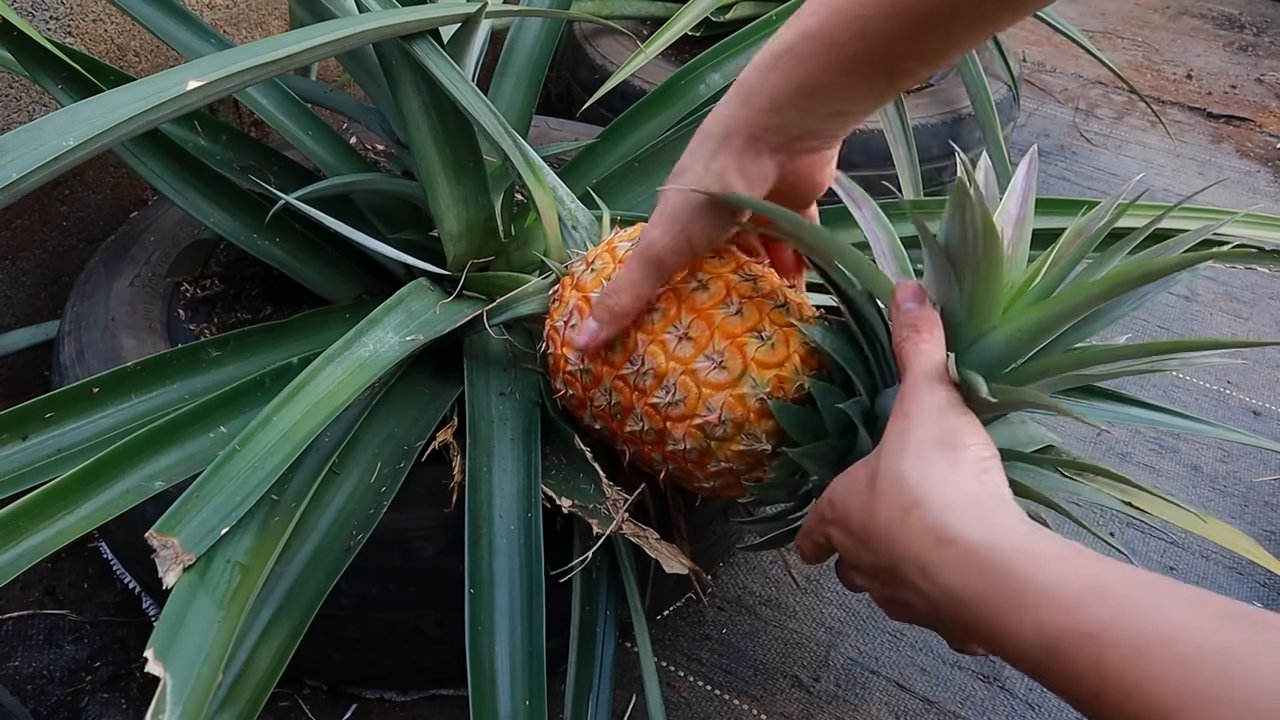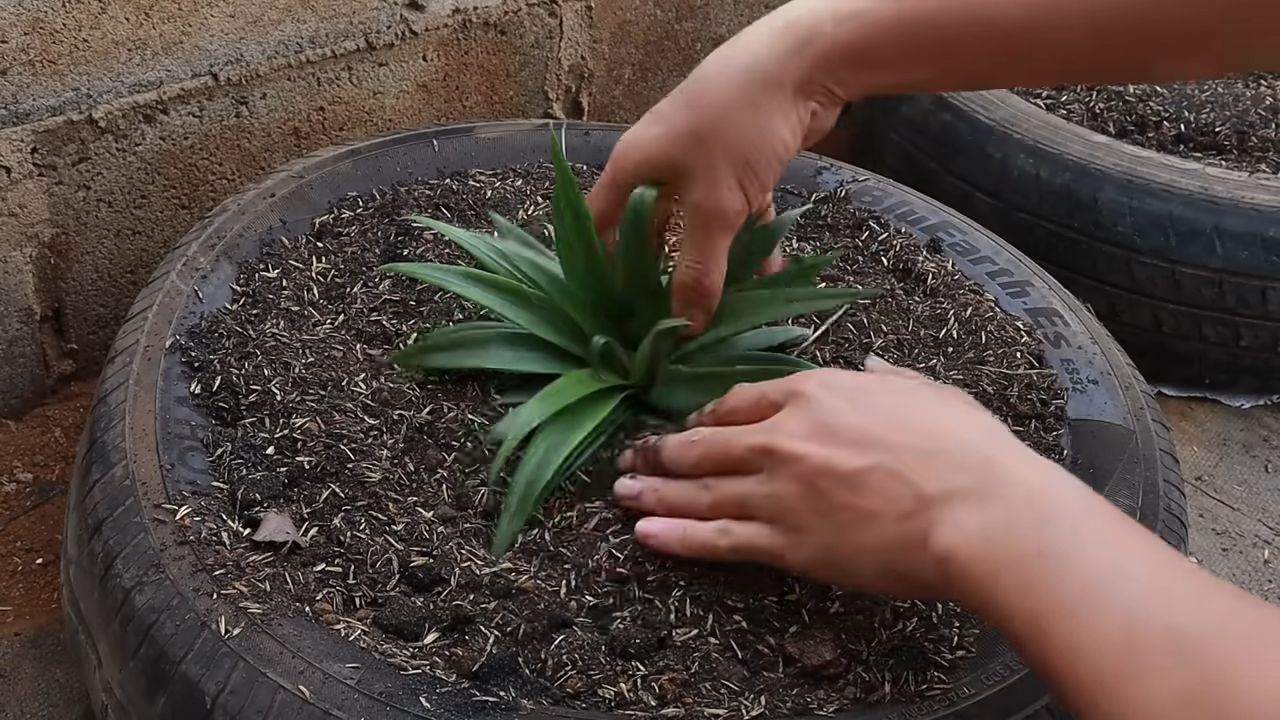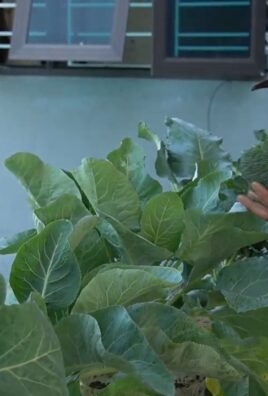Growing Pineapple at Home might seem like an exotic dream reserved for tropical climates, but I’m here to tell you it’s absolutely achievable, even if you’re miles away from Hawaii! Forget those expensive grocery store pineapples – imagine plucking a juicy, sun-ripened pineapple straight from your own backyard (or balcony!).
The pineapple, a symbol of hospitality and welcome, has a rich history, gracing the tables of royalty and becoming a coveted delicacy. Its journey from South America to the rest of the world is a testament to its irresistible appeal. For centuries, it has been a symbol of luxury and exoticism. Now, you can bring a piece of that history into your own home.
Why should you embark on this DIY adventure? Well, besides the sheer satisfaction of nurturing a plant from humble beginnings to a delicious fruit, growing pineapple at home is incredibly rewarding. It’s a fantastic way to reduce your carbon footprint by avoiding long-distance transportation of store-bought fruit. Plus, homegrown pineapples often taste sweeter and more flavorful than anything you can buy. I’m going to guide you through simple, step-by-step instructions and insider tips to ensure your pineapple-growing journey is a success. Get ready to impress your friends and family with your newfound green thumb and enjoy the sweet taste of your own homegrown pineapple!

Growing Your Own Pineapple: A Tropical Treat at Home!
Hey there, fellow plant enthusiasts! Ever dreamed of harvesting your own juicy pineapple right from your backyard (or even your windowsill)? Well, dream no more! Growing a pineapple at home is surprisingly achievable, and I’m here to guide you through the entire process. It takes patience, but the reward of a homegrown pineapple is totally worth it.
Choosing Your Pineapple Top
The first, and arguably most important, step is selecting the right pineapple top. Not all pineapples are created equal when it comes to propagation.
* Look for a healthy pineapple: Choose a pineapple from the grocery store that looks fresh and vibrant. Avoid pineapples with brown, mushy, or damaged leaves. The leaves should be a healthy green color.
* Check the crown: The crown (the leafy top) should be firm and tightly packed. Gently tug on a few leaves – they shouldn’t come off easily.
* Consider the variety: While most pineapples will work, some varieties are easier to grow than others. Smooth Cayenne is a popular and reliable choice.
Preparing the Pineapple Top
Okay, you’ve got your pineapple. Now it’s time to prep that crown for planting!
1. Twist or Cut off the Crown: This is where you separate the crown from the fruit. I prefer to twist it off. Grip the base of the crown firmly and twist it away from the fruit. If twisting doesn’t work easily, you can carefully cut it off with a sharp knife, leaving about an inch of fruit attached.
2. Remove the Bottom Leaves: This is crucial! You need to remove several layers of the bottom leaves to expose the stem. Gently peel off the lower leaves, working your way up until you have about 1-2 inches of bare stem. This exposed stem is where the roots will emerge. Be careful not to damage the stem itself.
3. Let it Callus: This step helps prevent rot. Place the prepared crown in a cool, dry place for 3-7 days. This allows the cut end to callus over, forming a protective layer. You’ll know it’s ready when the cut end feels dry and slightly hardened.
Rooting the Pineapple Top
Now for the exciting part – getting those roots to sprout! You have two main options here: rooting in water or planting directly in soil. I’ll cover both.
Rooting in Water (My Preferred Method)
I find rooting in water gives you a better visual of root development.
1. Choose a Container: Select a clear glass or jar that’s wide enough to support the pineapple crown and deep enough to hold water without submerging the leaves.
2. Add Water: Fill the container with fresh, clean water. Make sure the water level only covers the bottom inch or two of the stem. You don’t want the leaves to be submerged, as this can cause them to rot.
3. Place the Crown in Water: Carefully place the pineapple crown in the container, ensuring that only the exposed stem is submerged.
4. Find a Sunny Spot: Place the container in a warm, bright location with indirect sunlight. Avoid direct sunlight, which can scorch the leaves.
5. Change the Water Regularly: Change the water every 2-3 days to keep it fresh and prevent algae growth.
6. Wait for Roots: Be patient! It can take several weeks (2-8 weeks) for roots to appear. You should start to see small, white roots emerging from the stem.
7. Plant When Roots are Established: Once the roots are about 2-3 inches long, your pineapple top is ready to be planted in soil.
Rooting Directly in Soil
This method skips the water rooting process and plants the crown directly into soil.
1. Prepare the Pot and Soil: Choose a pot that’s at least 6 inches in diameter and has drainage holes. Use a well-draining potting mix. A mix of potting soil, perlite, and sand works well.
2. Plant the Crown: Make a hole in the center of the pot and carefully plant the pineapple crown, burying the stem up to the base of the leaves.
3. Water Thoroughly: Water the soil thoroughly after planting, allowing excess water to drain out.
4. Find a Sunny Spot: Place the pot in a warm, bright location with indirect sunlight.
5. Keep the Soil Moist: Keep the soil consistently moist, but not soggy. Water when the top inch of soil feels dry.
6. Wait for Growth: It can take several weeks or even months for the pineapple to establish roots and start growing. You’ll know it’s successful when you see new leaves emerging from the center of the crown.
Planting Your Rooted Pineapple
Whether you rooted in water or directly in soil, the next step is planting your pineapple in a larger pot.
1. Choose a Larger Pot: Select a pot that’s at least 10-12 inches in diameter. Pineapples need room to grow.
2. Prepare the Soil: Use a well-draining potting mix. Again, a mix of potting soil, perlite, and sand is ideal. You can also add some compost for extra nutrients.
3. Carefully Remove the Pineapple: If you rooted in water, gently remove the pineapple crown from the container, being careful not to damage the roots. If you rooted directly in soil, simply leave it in its current pot.
4. Plant the Pineapple: Make a hole in the center of the larger pot and carefully plant the pineapple, ensuring that the roots are covered with soil.
5. Water Thoroughly: Water the soil thoroughly after planting, allowing excess water to drain out.
Caring for Your Pineapple Plant
Now that your pineapple is planted, it’s time to provide the care it needs to thrive.
* Sunlight: Pineapples need plenty of sunlight. Aim for at least 6 hours of direct sunlight per day. If you’re growing your pineapple indoors, place it near a sunny window or use a grow light.
* Watering: Water your pineapple regularly, especially during the growing season (spring and summer). Water when the top inch of soil feels dry. Avoid overwatering, which can lead to root rot.
* Fertilizing: Feed your pineapple plant with a balanced liquid fertilizer every 2-3 months during the growing season. Follow the instructions on the fertilizer label.
* Temperature: Pineapples thrive in warm temperatures (65-85°F or 18-29°C). Protect your plant from frost and cold temperatures.
* Humidity: Pineapples prefer moderate humidity. If you live in a dry climate, you can increase humidity by misting the leaves regularly or placing the pot on a tray filled with pebbles and water.
* Repotting: As your pineapple grows, you may need to repot it into a larger container. Repotting is usually necessary every 1-2 years.
Encouraging Fruiting
Getting your pineapple plant to produce fruit can take some time and patience. It typically takes 2-3 years for a pineapple plant grown from a top to produce a fruit. Here are some tips to encourage fruiting:
* Ethylene Gas: Ethylene gas can help induce flowering. You can create ethylene gas by placing a ripe apple near the pineapple plant and covering both with a plastic bag for a few days. Be careful not to overheat the plant in the bag.
* Magnesium Sulfate (Epsom Salts): Some gardeners recommend applying magnesium sulfate (Epsom salts) to the soil to encourage flowering. Dissolve 1 tablespoon of Epsom salts in 1 gallon of water and water the plant with this solution every few months.
* Patience: The most important thing is to be patient! It can take time for your pineapple plant to mature and produce fruit.
Harvesting Your Pineapple
Finally, the moment you’ve been waiting for – harvesting your homegrown pineapple!
* Signs of Ripeness: A ripe pineapple will have a sweet aroma and a slightly golden color. The eyes (the individual segments of the fruit) will be more flattened and less prominent.
* Harvesting: To harvest your pineapple, use a sharp knife to cut the fruit from the plant. Leave a few inches of stem attached to the pineapple.
* Enjoy! Now you can enjoy the delicious taste of your homegrown pineapple!
Troubleshooting
Even with the best care, you might encounter some challenges along the way. Here are a few common problems and how to address them:
* Yellowing Leaves: Yellowing leaves can be a sign of overwatering, underwatering, or nutrient deficiency. Adjust your watering schedule and fertilize your plant if necessary.
* Brown Leaf Tips: Brown leaf tips can be caused by dry air or excessive fertilizer. Increase humidity and reduce fertilizer applications.
* Root Rot: Root rot is caused by overwatering and poor drainage. Make sure your

Conclusion
So, there you have it! Growing pineapple at home, while it requires patience, is an incredibly rewarding experience. It’s more than just a fun gardening project; it’s a chance to connect with nature, learn about the life cycle of a fascinating fruit, and ultimately, enjoy the sweet taste of success – literally! This DIY trick transforms a simple pineapple top, often discarded, into a thriving plant that can eventually yield its own delicious fruit.
Why is this a must-try? Because it’s sustainable, educational, and ultimately, delicious. You’re reducing food waste, learning about botany firsthand, and gaining access to a homegrown pineapple that tastes far superior to anything you can buy in a store. The flavor of a homegrown pineapple, ripened perfectly on the plant, is an explosion of tropical sweetness that will redefine your understanding of this iconic fruit. Plus, imagine the bragging rights!
But the fun doesn’t stop there. Consider experimenting with different pineapple varieties. ‘Smooth Cayenne’ is a popular choice for its ease of growth and delicious fruit, but you could also try ‘Red Spanish’ for its vibrant color or ‘Sugarloaf’ for its exceptionally sweet taste. You can also play around with different potting mixes to see what works best in your local climate. Some gardeners swear by a mix of perlite, peat moss, and vermiculite, while others prefer a more organic blend with compost and coconut coir. Don’t be afraid to experiment and find what your pineapple plant loves.
Another variation to consider is the container you use. While a standard pot works perfectly well, you could also try growing your pineapple in a raised bed or even a large container garden alongside other tropical plants. This can create a beautiful and productive mini-ecosystem in your backyard.
We wholeheartedly encourage you to give this DIY trick a try. It’s a project that’s suitable for gardeners of all levels, from beginners to seasoned pros. The process is relatively simple, the materials are readily available, and the rewards are immeasurable.
Once you’ve embarked on your pineapple-growing journey, we’d love to hear about your experience! Share your photos, tips, and challenges in the comments below. Let’s create a community of pineapple enthusiasts and learn from each other’s successes and failures. Together, we can unlock the secrets to growing the perfect homegrown pineapple and enjoy the fruits (pun intended!) of our labor. So, grab a pineapple, save the top, and get ready to embark on a tropical adventure right in your own backyard! Don’t forget that proper drainage is key to success when growing pineapple at home.
Frequently Asked Questions (FAQ)
How long does it take to grow a pineapple from a top?
Patience is key! It typically takes anywhere from 2 to 3 years for a pineapple plant grown from a top to produce fruit. The exact timeframe depends on several factors, including the variety of pineapple, the climate, the amount of sunlight the plant receives, and the overall care it receives. Don’t be discouraged if it takes longer than expected; the wait will be worth it!
What kind of soil is best for growing pineapple?
Pineapples thrive in well-draining, slightly acidic soil. A good potting mix should be light and airy, allowing for proper root development and preventing waterlogging. A mix of equal parts perlite, peat moss, and vermiculite is a popular choice. You can also add some compost or coconut coir to improve drainage and nutrient content. Avoid heavy clay soils, as they can retain too much moisture and lead to root rot.
How much sunlight does a pineapple plant need?
Pineapples are sun-loving plants and require at least 6 hours of direct sunlight per day. If you’re growing your pineapple indoors, place it near a south-facing window where it can receive ample sunlight. You may also need to supplement with artificial light, especially during the winter months. Insufficient sunlight can result in slow growth and reduced fruit production.
How often should I water my pineapple plant?
Water your pineapple plant regularly, especially during the growing season (spring and summer). Allow the soil to dry out slightly between waterings, but avoid letting it dry out completely. Overwatering can lead to root rot, so it’s important to ensure proper drainage. In the winter, reduce watering frequency as the plant’s growth slows down. A good rule of thumb is to water when the top inch of soil feels dry to the touch.
How do I fertilize my pineapple plant?
Pineapples are heavy feeders and benefit from regular fertilization. Use a balanced fertilizer (e.g., 10-10-10) diluted to half strength every 2-3 months during the growing season. You can also use a liquid fertilizer specifically formulated for bromeliads. Avoid over-fertilizing, as this can damage the plant. Look for fertilizers that contain micronutrients like iron and manganese, which are essential for healthy growth.
How do I know when my pineapple is ripe?
Determining when a pineapple is ripe can be tricky, but there are a few telltale signs. The pineapple should have a vibrant color, ranging from green to golden yellow, depending on the variety. The fruit should also have a sweet, fragrant aroma. Gently tug on one of the leaves near the top of the pineapple; if it comes off easily, the pineapple is likely ripe. You can also tap the pineapple; a ripe pineapple will have a dull, thudding sound.
Can I grow pineapple indoors?
Yes, you can absolutely grow pineapple indoors, especially if you live in a climate with cold winters. Choose a large pot with good drainage and place it in a sunny location. You may need to supplement with artificial light to ensure the plant receives enough sunlight. Indoor-grown pineapples may take longer to fruit than those grown outdoors, but with proper care, you can still enjoy homegrown pineapples even in colder climates.
What are some common problems when growing pineapple?
Some common problems when growing pineapple include root rot (caused by overwatering), mealybugs, scale insects, and nutrient deficiencies. Root rot can be prevented by ensuring proper drainage and avoiding overwatering. Mealybugs and scale insects can be treated with insecticidal soap or neem oil. Nutrient deficiencies can be addressed by fertilizing regularly with a balanced fertilizer. Regularly inspect your pineapple plant for signs of pests or diseases and take action promptly to prevent them from spreading.
My pineapple plant has flowered, what happens next?
Congratulations! Once your pineapple plant flowers, it means it’s getting ready to produce fruit. After the flower fades, a small pineapple will begin to develop at the base of the flower stalk. It will take several months for the pineapple to fully mature and ripen. Continue to provide your plant with plenty of sunlight, water, and fertilizer during this time. Be patient, and soon you’ll be enjoying your own homegrown pineapple!
Can I grow pineapple in colder climates?
While pineapples thrive in warm, tropical climates, you can still grow them in colder climates with a little extra care. Grow your pineapple in a pot so you can easily move it indoors during the winter months. Provide supplemental lighting if needed, and be sure to protect the plant from frost and freezing temperatures. With proper care, you can enjoy homegrown pineapples even in colder climates.





Leave a Comment